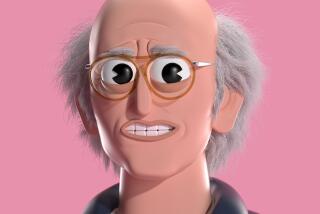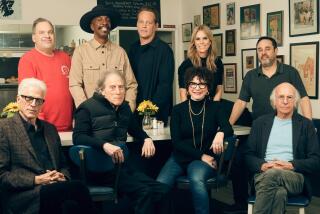Grumpy charms shine through
- Share via
WHEN Ang Lee was outside of Calgary shooting “Brokeback Mountain” last year, he spent hours one day trying to film a sequence of sheep drinking from a babbling brook. As the day wore on, Diana Ossana, the film’s co-writer and producer, got on the phone to share the news with novelist Larry McMurtry, who had collaborated on the script with her.
McMurtry, a native Texan, knew just what Ossana was thinking. “Hasn’t anyone told him sheep won’t drink from a brook?” he said. “They’ll only drink from still water.” Eventually Lee gave up, never having gotten the shot. For McMurtry, it was deja vu all over again.
Forty years ago, when Hollywood and Paul Newman came to the Texas panhandle to make “Hud,” McMurty had witnessed a similar incident. “Hud’s” director was trying to film a flock of buzzards waiting for their moment to swoop down on a heifer’s carcass. The movie wranglers wired the buzzards to a tree, which resulted only in a tangle of upside-down buzzards. The shot was ultimately abandoned. As McMurtry later wrote, “It is hard to imagine anything less likely to beguile a movie-going audience than a tree full of dangling buzzards, nether parts exposed.”
In town the other day for a rare interview, McMurtry is considerably less sardonic about “Brokeback Mountain,” perhaps because so much effort went into getting it made. The original story, written by E. Annie Proulx, appeared in the New Yorker in 1997. McMurtry and Ossana optioned it with their own money, wrote the script together and spent nearly eight years struggling to get it made. Skittish about making any sort of drama these days, Hollywood was especially wary about the tale of two cowboys who meet one summer tending sheep on an open range and fall in love.
But now things are looking up. The film, which was named the year’s best picture by the Los Angeles Film Critics Assn., has earned rhapsodic reviews, both for Lee and for his lead actors, Jake Gyllenhaal and Heath Ledger.
It feels especially poignant to see the pent-up emotion and repression that is so present in Lee’s other films, especially “Crouching Tiger, Hidden Dragon,” transferred to the iconic American West. As Entertainment Weekly critic Owen Gleiberman wrote, “In an age where the fight over gay marriage still rages, ‘Brokeback Mountain,’ the tale of two men who are scarcely even allowed to imagine being together, asks ... when it comes to love, what sort of world do we really want?”
The film adaptation, which hews closely to the gnarled roots of Proulx’s story while carefully fleshing out her character’s lives, is something of a late-career capstone for McMurtry. Best known for dozens of popular novels -- he won the Pulitzer Prize for fiction in 1986 for “Lonesome Dove” -- he’s one of a handful of gifted writers who’s actually seen his work treated well by Hollywood. In fact, it’s hard to imagine any writer who’s had a longer and more fruitful association with film and TV. His first novel, “Horseman, Pass By,” was made as “Hud” with Newman as its venal Cadillac-driving cowboy. Other successful adaptations of his work have included “The Last Picture Show,” which McMurtry wrote with Peter Bogdanovich; “Terms of Endearment,” which won an Oscar for best picture; and “Lonesome Dove,” the Emmy-winning miniseries with Robert Duvall and Tommy Lee Jones.
At 69, McMurtry continues to publish books at a rate that would put younger writers to shame. But his Hollywood star has dimmed. His most recent screen work, with Ossana, was for “The Johnson County War,” a little-seen cable TV miniseries.
McMurtry has a certain grumpy charm that has served him well as a writer but keeps the rest of us on our toes.
“Larry doesn’t tolerate laggards or rudeness or laziness, and he can’t abide people who are late,” says Ossana, who has been a constant in McMurtry’s life for two-plus decades. They live together much of the time in Tucson, where Ossana has a home, though it is made clear that they are devoted friends, not lovers.
McMurtry doesn’t own a cellphone or a computer, preferring to write on a Hermes 3000 manual typewriter. He also has no use for the modern art of self-promotion. Although he’s endured brief question-and-answer sessions about “Brokeback Mountain,” it has clearly taken its toll. When McMurtry arrived at a radio station the other day to promote the film, the interviewer, noting his glum expression, said, “You look like you don’t want to be here.” McMurtry’s response: “I don’t.”
McMurtry gets along best with women, his circle of female friends including Ossana, Diane Keaton and Polly Platt, whom he met when she was married to Bogdanovich and at work on “The Last Picture Show.” “Women love Larry because he’s one of those few men who’s a good listener,” says Platt. “There’s something about him that’s such a mystery -- he’s the unknowable man.”
When you think of his films, it is the women who immediately come to mind, be it Cybill Shepherd from “Picture Show” or Shirley MacLaine in “Terms of Endearment.” In his books, two men often fall for the same woman, which makes his work on “Brokeback” so intriguing, because in Proulx’s story, the two men fall for each other.
McMurtry once wrote about his boyhood days in Texas that “a charge of homosexuality, directly leveled, would have produced a fight instantly.” But he says he had a gay relative who was allowed a “don’t ask, don’t tell” existence. “When he came to our family gatherings in the 1950s, we were pointedly told to be nice to his gentleman friend,” he recalls. “He never had any trouble, perhaps because he had clan protection -- there were a lot of McMurtrys around.”
Even today, the prospect of making a film about a love affair between two men was a challenging proposition. Though Rudin and director Gus Van Sant were enthusiasts, they could never cast the film. As Ossana recalls, Joaquin Phoenix was willing to play Jack Twist, but “actors would read for the Ennis del Mar part and they’d struggle or get anguished and we just couldn’t cast it.”
After Rudin’s option expired, other filmmakers expressed interest, but casting problems would always arise. Finally Focus Features signed on, in part because of enthusiasm from Focus chief James Schamus, who had optioned the story in 2001 when he was running another company. A longtime collaborator with Lee, Schamus got the director involved, which in turn gave the project access to a larger pool of established actors.
Although Ossana, who produced the film with Schamus, was on the set every day, McMurtry steered clear. He’s deathly allergic to a particular kind of Rocky Mountain foliage, but he also seems allergic to playing the role of author on a movie set. “I’m too deaf to hear the actors and too blind to see through the monitors,” he says. “I just get cranky and irritable and make the actors nervous.”
He doesn’t seem to have hit it off with Lee either. Recalling their one meeting, he dryly explains, “Ang didn’t say very much. I think he might’ve been fatigued.” Lee is famously uncommunicative on his film sets, so it was hardly surprising to hear Ossana say that, outside of social occasions, she spoke to him only twice on the set.
The groundswell of praise for the film seems to have assuaged any bruised feelings. “When I saw the film, I was as moved as I’ve ever been by any movie from my books,” McMurtry says. “I was even moved before we got to the story -- I loved the way the landscape of the northern Plains looked so sad.”
It’s a high compliment coming from McMurtry, who admits he rarely watches movies anymore. “I keep up on what’s going on through osmosis. I know a lot about movies without seeing them, which I guess is evocative of our age. After all, when I go to studios today, I feel like I’m talking to my grandchildren. We’re getting older and the executives keep getting younger.”
McMurtry sighs. “I’m not despairing. The movies have been good to me. I’ve had more fun in Hollywood than anywhere.”
More to Read
Only good movies
Get the Indie Focus newsletter, Mark Olsen's weekly guide to the world of cinema.
You may occasionally receive promotional content from the Los Angeles Times.










